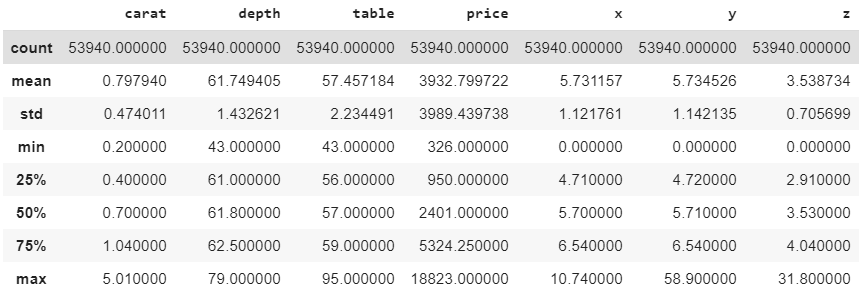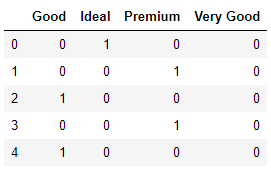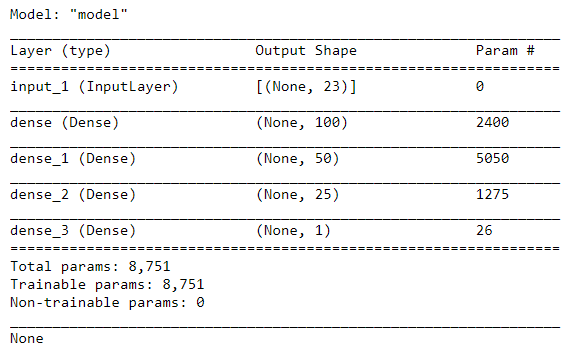Our last tutorial described how to use TensorFlow for Data Classification. In this article, we’ll teach you how to perform regression tasks with Python’s TensorFlow 2.0. You’ll develop a simple deep learning model capable of predicting the price of Diamonds. This is going to be a fun tutorial, so let’s get started!
Environment Setup
Before you can create a deep learning model for regression in TensorFlow 2.0, you have to install and import a few libraries.
To install the TensorFlow 2.0 library, you can use pip installer. The following command installs the TensorFlow 2.0 library:
$ pip install tensorflow
If you have an old version of TensorFlow already installed, you can update your TensorFlow to version 2.0 via the following command:
pip install --upgrade tensorflow
The other libraries you will need to install in order to execute the scripts in this tutorial are Pandas, Seaborn, NumPy, Scikit-Learn, and Matplotlib. The following script installs these libraries:
pip install matplotlib pip install seaborn pip install pandas pip install NumPy pip install scikit-learn
Import Required Libraries
Before we actually perform regression with TensorFlow 2.0, let’s first import the seaborn, matplotlib, pandas and TensorFlow modules that we’re going to need in this tutorial:
import seaborn as sns
import pandas as pd
import numpy as np
from tensorflow.keras.layers import Input, Dense, Dropout, Activation
from tensorflow.keras.models import ModelYou’re going to see how we use each of these libraries a little later in this tutorials.
You can check the version of the TensorFlow installed on your system by executing the following Python Script:
tf.__version__As of the date of this publication, you should see “2.0.0” in the output.
Importing and Preprocessing the Dataset
We’ll be performing regression on the
reg_dataset = sns.load_dataset('diamonds')
reg_dataset.head()Output:

The output shows that the dataset has 10 columns. We’ll be predicting the values in the
Let’s see the shape of our dataset.
reg_dataset.shapeOutput:
(53940, 10)The output shows that our dataset contains 53940 rows and 10 columns. To display the statistical information about the numeric columns, you can use the describe() method as shown below.
reg_dataset.describe()Output:

One Hot Encoding of Categorical Columns
If you look at the dataset, you can see that we have some columns with categorical or string type values e.g.
Step 1: For each unique value in the original categorical column, you create a new column. In our example, the
list(reg_dataset.cut.unique())Output:
['Ideal', 'Premium', 'Good', 'Very Good', 'Fair']To one hot encode the
Step 2: Next, among the new columns, add one to the column that corresponds to the original value in the
This will be more clear with an example. Let’s first remove the
numeric_data= reg_dataset.drop(['cut','color', 'clarity'], axis=1)To one hot encode a column, you can use the pd.get_dummies() method as shown below.
cut_onehot = pd.get_dummies(reg_dataset.cut).iloc[:,1:]
color_onehot = pd.get_dummies(reg_dataset.color).iloc[:,1:]
clarity_onehot = pd.get_dummies(reg_dataset.clarity).iloc[:,1:]Let’s now print the one hot encoded columns for the original
cut_onehot.head()Output:

From the output, you can see that 4 columns have been created instead of 5. A column for value
Step 3: Next, we need to concatenate the one hot encoded columns we just created with the numeric columns in the original dataset.
reg_dataset = pd.concat([numeric_data,cut_onehot, color_onehot,clarity_onehot], axis=1)
reg_dataset.head()Here is how our final dataset looks.
Output:

Dividing the Data into Training and Test Sets
Before we can train our deep learning models, we need to divide the data into feature and label sets. Our feature set will consist of all the columns except the
features = reg_dataset.drop(['price'], axis=1).values
labels = reg_dataset['price'].valuesNotice we use the drop command to quickly exclude a column from our features set.
In machine learning and deep learning, data is divided into the training and test sets. The training set is used to train a deep learning model while the test set is used to evaluate the performance of the trained model. The following script divides the data into an 80% training set and a 20% test set. This ratio is defined by the test_size attribute of the train_test_split() function as shown below:
from sklearn.model_selection import train_test_split
X_train, X_test, y_train, y_test = train_test_split(features, labels, test_size=0.2, random_state=40)Next, before we train our deep learning model, we need to scale our data. Scaling can be useful since the magnitude of data in different columns can vary greatly. It’s a good practice to scale the dataset so that all the columns have similar data scales.
from sklearn.preprocessing import StandardScaler
sc = StandardScaler()
X_train = sc.fit_transform(X_train)
X_test = sc.transform(X_test)Training Regression Models in TensorFlow 2.0
Defining TensorFlow models
In this example, our TensorFlow model will be simple. It will consist of a densely connected neural network. If you are not familiar to neural networks, check out this link.
Our neural network will contain an input layer, three hidden layers and one output layer. The hidden layers will be densely connected. The first layer contains 100 neurons, the second hidden layer contains 50 neurons, and the third hidden layer contains 25 neurons. You can play around with these values to see if you get better results. Since the output is a single value, i.e. the price of diamond, the output layer will contain only 1 neuron. The following script defines our model.
input_layer = Input(shape=(features.shape[1],))
l1 = Dense(100, activation='relu')(input_layer)
l2 = Dense(50, activation='relu')(l1)
l3 = Dense(25, activation='relu')(l2)
output = Dense(1)(l3)The above script creates our neural network model. To compile the model, the
Next you need to compile the model. To compile the model, the compile() method is used.
model = Model(inputs=input_layer, outputs=output)
model.compile(loss="mean_absolute_error" , optimizer="adam", metrics=["mean_absolute_error"])Let’s print the model summar. To do so, you can use the summary() method of the model object.
print(model.summary())Output:

Once the model is created, you have can train it by simply calling the
history = model.fit(X_train, y_train, batch_size=2, epochs=20, verbose=1, validation_split=0.2)While the model is being trained, you can see the accuracy obtained after each epoch. The output below only shows the results from the last 5 epochs, but you should see result from all 20 epochs.
Output:
2.0520 - val_mean_absolute_error: 352.0527
Epoch 17/20
34521/34521 [==============================] - 28s 820us/sample - loss: 320.8634 - mean_absolute_error: 320.8634 - val_loss: 372.6321 - val_mean_absolute_error: 372.6329
Epoch 18/20
34521/34521 [==============================] - 28s 825us/sample - loss: 320.5240 - mean_absolute_error: 320.5243 - val_loss: 361.3044 - val_mean_absolute_error: 361.3043
Epoch 19/20
34521/34521 [==============================] - 29s 849us/sample - loss: 318.1330 - mean_absolute_error: 318.1321 - val_loss: 364.1879 - val_mean_absolute_error: 364.1886
Epoch 20/20
34521/34521 [==============================] - 37s 1ms/sample - loss: 316.9341 - mean_absolute_error: 316.9344 - val_loss: 353.8328 - val_mean_absolute_error: 353.8323Evaluating Model performance
Now that our diamond price model is trained with TensorFlow 2.0, we can see how good our regression model is. To evaluate the performance of a regression, the most commonly used metric is the mean absolute error, which gives us the average error between the predicted and actual values across all the test examples. The following script finds the mean absolute error for our training and testing set.
from sklearn.metrics import mean_absolute_error
from math import sqrt
pred_train = model.predict(X_train)
print(mean_absolute_error(y_train,pred_train))
pred = model.predict(X_test)
print(mean_absolute_error(y_test,pred))Output:
319.3074745419382
324.4026458055654The output shows that on average, there is a difference of only $324 between the predicted and actual values and the values predicted by our model. This is less than 10% of the average values of all the diamonds in our dataset ($3932.79) which means our model is pretty accurate.
Complete Code
To help you build your own regression model, here’s our complete code for predicting diamond prices using Tensorflow 2.0 in this tutorial:
import seaborn as sns
import pandas as pd
import numpy as np
import tensorflow as tf
from tensorflow.keras.layers import Input, Dense, Dropout, Activation
from tensorflow.keras.models import Model
tf.__version__
reg_dataset = sns.load_dataset('diamonds')
reg_dataset.head()
reg_dataset.shape
reg_dataset.describe()
list(reg_dataset.cut.unique())
numeric_data= reg_dataset.drop(['cut','color', 'clarity'], axis=1)
cut_onehot = pd.get_dummies(reg_dataset.cut).iloc[:,1:]
color_onehot = pd.get_dummies(reg_dataset.color).iloc[:,1:]
clarity_onehot = pd.get_dummies(reg_dataset.clarity).iloc[:,1:]
cut_onehot.head()
reg_dataset = pd.concat([numeric_data,cut_onehot, color_onehot,clarity_onehot], axis=1)
reg_dataset.head()
features = reg_dataset.drop(['price'], axis=1).values
labels = reg_dataset['price'].values
from sklearn.model_selection import train_test_split
X_train, X_test, y_train, y_test = train_test_split(features, labels, test_size=0.2, random_state=40)
from sklearn.preprocessing import StandardScaler
sc = StandardScaler()
X_train = sc.fit_transform(X_train)
X_test = sc.transform(X_test)
input_layer = Input(shape=(features.shape[1],))
l1 = Dense(100, activation='relu')(input_layer)
l2 = Dense(50, activation='relu')(l1)
l3 = Dense(25, activation='relu')(l2)
output = Dense(1)(l3)
model = Model(inputs=input_layer, outputs=output)
model.compile(loss="mean_absolute_error" , optimizer="adam", metrics=["mean_absolute_error"])
print(model.summary())
history = model.fit(X_train, y_train, batch_size=2, epochs=20, verbose=1, validation_split=0.2)
from sklearn.metrics import mean_absolute_error
from math import sqrt
pred_train = model.predict(X_train)
print(mean_absolute_error(y_train,pred_train))
pred = model.predict(X_test)
print(mean_absolute_error(y_test,pred))For more Python programs like this, subscribe using the form below:
